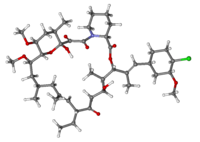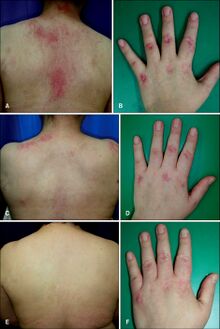Pimecrolimus
 | |
 | |
| Names | |
|---|---|
| Trade names | Elidel |
| |
| Clinical data | |
| Drug class | Calcineurin inhibitor[1] |
| Main uses | Atopic dermatitis (eczema), psoriasis[1][2] |
| Side effects | Skin reaction, headache, cough[1] |
| Pregnancy category |
|
| Routes of use | topical |
| Typical dose | 1% BID[1] |
| External links | |
| AHFS/Drugs.com | Monograph |
| Legal | |
| Legal status |
|
| Pharmacokinetics | |
| Bioavailability | low systemic absorption |
| Protein binding | 74%–87% |
| Metabolism | Hepatic CYP3A |
| Chemical and physical data | |
| Formula | C43H68ClNO11 |
| Molar mass | 810.46 g·mol−1 |
| 3D model (JSmol) | |
| |
| |
Pimecrolimus, sold under the brand name Elidel, is a medication used to treat atopic dermatitis (eczema) and psoriasis.[1][2] It is a second line treatment after topical corticosteroids.[1] It is applied to the skin as a cream.[1]
Common side effects include skin reaction, headache, and cough.[1] Other concerns may include cancer and infections.[1] Use is not recommended in pregnancy.[2] It is a calcineurin inhibitor.[1]
was approved for medical use in the United States in 2001.[1] In the United Kingdom a 30 gram tube costs the NHS about £20 as of 2021.[2] This amount in the United States is about 70 USD.[3]
Medical uses

It is effective in various inflammatory skin diseases, e.g., seborrheic dermatitis,[4] cutaneous lupus erythematosus,[5] oral lichen planus,[6] vitiligo,[7] and psoriasis.[8][9] Tacrolimus and pimecrolimus are both calcineurin inhibitors and function as immunosuppressants.[10]
Dosage
It comes as a 1% cream which is applied twice per day.[1]
Side effects
In January 2006, the United States Food and Drug Administration (FDA) announced that Elidel packaging would be required to carry a black box warning regarding the potential increased risk of lymph node or skin cancer, as for the similar drug tacrolimus. Whereas current practice by UK dermatologists is not to consider this a significant real concern and they are increasingly recommending the use of such new drugs.[11]
Importantly, although the FDA has approved updated black-box warning for tacrolimus and pimecrolimus, the recent report of the American Academy of Dermatology Association Task Force finds that there is no causal proof that topical immunomodulators cause lymphoma or nonmelanoma skin cancer, and systemic immunosuppression after short-term or intermittent long-term topical application seems an unlikely mechanism.[12] Another recent review of evidence concluded that postmarketing surveillance shows no evidence for this systemic immunosuppression or increased risk for any malignancy.[13] However, strong debates and controversies continue regarding the exact indications of immunomodulators and their duration of use in the absence of active controlled trials.[14] Dermatologists' and allergists' professional societies, the American Academy of Dermatology,[15] and the American Academy of Allergy, Asthma, and Immunology, have protested the inclusion of the black box warning. The AAAAI states "None of the information provided for the cases of lymphoma associated with the use of topical pimecrolimus or tacrolimus in AD indicate or suggest a causal relationship."[16]
Pharmacology
Pimecrolimus is an ascomycin macrolactam derivative. It has been shown in vitro that pimecrolimus binds to FKBP1A and also inhibits calcineurin.[citation needed] Thus pimecrolimus inhibits T-cell activation by inhibiting the synthesis and release of cytokines from T-cells. Pimecrolimus also prevents the release of inflammatory cytokines and mediators from mast cells.[citation needed]
Pimecrolimus, like tacrolimus, belongs to the ascomycin class of macrolactam immunosuppressives, acting by the inhibition of T-cell activation by the calcineurin pathway and inhibition of the release of numerous inflammatory cytokines, thereby preventing the cascade of immune and inflammatory signals.[17] Pimecrolimus has a similar mode of action to that of tacrolimus but is more selective, with no effect on dendritic (Langerhans) cells.[18] It has lower permeation through the skin than topical steroids or topical tacrolimus[19] although they have not been compared with each other for their permeation ability through mucosa. In addition, in contrast with topical steroids, pimecrolimus does not produce skin atrophy.[20]
References
- ↑ 1.00 1.01 1.02 1.03 1.04 1.05 1.06 1.07 1.08 1.09 1.10 1.11 "Pimecrolimus Monograph for Professionals". Drugs.com. Archived from the original on 8 October 2021. Retrieved 28 October 2021.
- ↑ 2.0 2.1 2.2 2.3 BNF 81: March-September 2021. BMJ Group and the Pharmaceutical Press. 2021. p. 1299. ISBN 978-0857114105.
- ↑ "Pimecrolimus Prices and Pimecrolimus Coupons - GoodRx". GoodRx. Archived from the original on 8 May 2016. Retrieved 28 October 2021.
- ↑ Firooz A, Solhpour A, Gorouhi F, Daneshpazhooh M, Balighi K, Farsinejad K, Rashighi-Firoozabadi M, Dowlati Y (2006). "Pimecrolimus cream, 1%, vs hydrocortisone acetate cream, 1%, in the treatment of facial seborrheic dermatitis: a randomized, investigator-blind, clinical trial". Archives of Dermatology. 142 (8): 1066–1067. doi:10.1001/archderm.142.8.1066. PMID 16924062.
- ↑ Kreuter A, Gambichler T, Breuckmann F, Pawlak FM, Stücker M, Bader A, Altmeyer P, Freitag M (2004). "Pimecrolimus 1% cream for cutaneous lupus erythematosus". J Am Acad Dermatol. 51 (3): 407–410. doi:10.1016/j.jaad.2004.01.044. PMID 15337984.
- ↑ Gorouhi F, Solhpour A, Beitollahi JM, Afshar S, Davari P, Hashemi P, Nassiri Kashani M, Firooz A (2007). "Randomized trial of pimecrolimus cream versus triamcinolone acetonide paste in the treatment of oral lichen planus". J Am Acad Dermatol. 57 (5): 806–813. doi:10.1016/j.jaad.2007.06.022. PMID 17658663.
- ↑ Boone B, Ongenae K, Van Geel N, Vernijns S, De Keyser S, Naeyaert JM (2007). "Topical pimecrolimus in the treatment of vitiligo". Eur J Dermatol. 17 (1): 55–61. doi:10.1684/ejd.2007.0093 (inactive 31 May 2021). PMID 17324829.
{{cite journal}}: CS1 maint: DOI inactive as of May 2021 (link) - ↑ Kreuter A, Sommer A, Hyun J, Bräutigam M, Brockmeyer NH, Altmeyer P, Gambichler T (2006). "1% pimecrolimus, 0.005% calcipotriol, and 0.1% betamethasone in the treatment of intertriginous psoriasis: a double-blind, randomized controlled study". Arch Dermatol. 142 (9): 1138–1143. doi:10.1001/archderm.142.9.1138. PMID 16983001.
- ↑ Jacobi A, Braeutigam M, Mahler V, Schultz E, Hertl M (2008). "Pimecrolimus 1% cream in the treatment of facial psoriasis: a 16-week open-label study". Dermatology. 216 (2): 133–136. doi:10.1159/000111510. PMID 18216475. S2CID 35741213.
- ↑ Scheinfeld N (2004). "The use of topical tacrolimus and pimecrolimus to treat psoriasis: a review". Dermatol. Online J. 10 (1): 3. doi:10.5070/D35ZK7V6CS. PMID 15347485.
- ↑ N H Cox & Catherine H Smith (December 2002). "Advice to dermatologists re topical tacrolimus". Therapy Guidelines Committee. British Association of Dermatologists. Archived from the original (DOC) on 2006-05-25.
- ↑ Berger TG, Duvic M, Van Voorhees AS, VanBeek MJ, Frieden IJ, American Academy of Dermatology Association Task Force (2006). "The use of topical calcineurin inhibitors in dermatology: safety concerns Report of the American Academy of Dermatology Association Task Force". J Am Acad Dermatol. 54 (5): 818–823. doi:10.1016/j.jaad.2006.01.054. PMID 16635663.
- ↑ Spergel JM, Leung DY (2006). "Safety of topical calcineurin inhibitors in atopic dermatitis: evaluation of the evidence". Curr Allergy Asthma Rep. 6 (4): 270–274. doi:10.1007/s11882-006-0059-7. PMID 16822378. S2CID 40761750.
- ↑ Stern RS (2006). "Topical calcineurin inhibitors labeling: putting the "box" in perspective". Archives of Dermatology. 142 (9): 1233–1235. doi:10.1001/archderm.142.9.1233. PMID 16983018.
- ↑ "Statement Regarding FDA Decision On Two Eczema Medications By American Academy Of Dermatology". Archived from the original on 2008-04-07. Retrieved 2007-09-24.
- ↑ "Archived copy" (PDF). Archived from the original (PDF) on 2011-07-18. Retrieved 2007-09-24.
{{cite web}}: CS1 maint: archived copy as title (link) - ↑ Allen BR, Lakhanpaul M, Morris A, Lateo S, Davies T, Scott G, Cardno M, Ebelin ME, Burtin P, Stephenson TJ (2003). "Systemic exposure, tolerability, and efficacy of pimecrolimus cream 1% in atopic dermatitis patients". Arch Dis Child. 88 (11): 969–973. doi:10.1136/adc.88.11.969. PMC 1719352. PMID 14612358.
- ↑ Meingassner JG, Kowalsky E, Schwendinger H, Elbe-Bürger A, Stütz A (2003). "Pimecrolimus does not affect Langerhans cells in murine epidermis". Br J Dermatol. 149 (4): 853–857. doi:10.1046/j.1365-2133.2003.05559.x. PMID 14616380. S2CID 26517363.
- ↑ Billich A, Aschauer H, Aszódi A, Stuetz A (2004). "Percutaneous absorption of drugs used in atopic eczema: pimecrolimus permeates less through skin than corticosteroids and tacrolimus". Int J Pharm. 269 (1): 29–35. doi:10.1016/j.ijpharm.2003.07.013. PMID 14698574.
- ↑ Firooz A, Solhpour A, Gorouhi F, Daneshpazhooh M, Balighi K, Farsinejad K, Rashighi-Firoozabadi M, Dowlati Y (2006). "Pimecrolimus cream, 1%, vs hydrocortisone acetate cream, 1%, in the treatment of facial seborrheic dermatitis: a randomized, investigator-blind, clinical trial". Archives of Dermatology. 142 (8): 1066–1067. doi:10.1001/archderm.142.8.1066. PMID 16924062.
External links
| Identifiers: |
|
|---|
- FDA News Archived 2009-05-24 at the Wayback Machine
- NPS RADAR Archived 2008-07-19 at the Wayback Machine
- Article about American Academy of Dermatology speaking out against black box warning Archived 2008-04-07 at the Wayback Machine
- Report of the Calcineurin Task Force of the ACAAI and AAAAI
- Pages using duplicate arguments in template calls
- CS1 maint: DOI inactive as of May 2021
- CS1 maint: archived copy as title
- Chemical articles with unknown parameter in Infobox drug
- Chemical articles without CAS registry number
- Articles without EBI source
- Chemical pages without ChemSpiderID
- Chemical pages without DrugBank identifier
- Articles without KEGG source
- Articles without UNII source
- Drugs missing an ATC code
- Drugboxes which contain changes to verified fields
- Drugboxes which contain changes to watched fields
- All articles with unsourced statements
- Articles with unsourced statements from April 2016
- Articles with invalid date parameter in template
- Articles with changed EBI identifier
- Webarchive template wayback links
- Disulfiram-like drugs
- Immunosuppressants
- Macrolides
- Novartis brands
- RTT